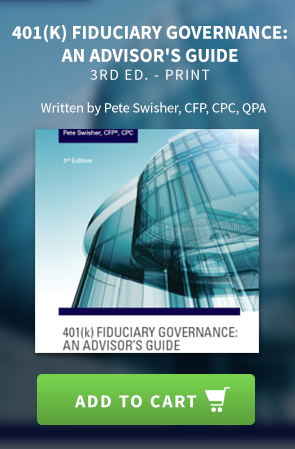403b Plans
The impact of the SECURE Act—the most significant retirement-related legislation in more than a decade—is well-known in many respects. Among the lesser-known impacts of the new law are those on 403(b) plans. A Feb. 11 NTSA webinar discussed them.
Andrew Remo, the American Retirement Association...
READ MORE
The American Retirement Association has outlined a number of high priority clarifications needed following passage of the SECURE Act.
In a letter dated Feb. 12, the ARA submitted to Carol Weiser, Benefits Tax Counsel at the U.S. Department of the Treasury, a list of “certain issues related to...
READ MORE
Tech Talk addresses whether a teacher who is retiring from the state public school system and who has elected a partial lump sum from the state retirement system can establish a 403(b) account post-employment to receive the rollover from the state retirement system.
READ MORE
Prior to the technical correction measures in the Job Creation and Worker Assistance Act of 2002, it was necessary to count “non-vested” amounts as contributions in the year vested for purposes of the IRC §415(c) limit. Now, the non-vested contributions will be counted as contributions in the year...
READ MORE
Designated Roth accounts are becoming more popular in the 403(b)/457(b) marketplace. As a 403(b)/457(b) retirement trainer, it has become apparent in the time I spend on Roth questions, that agents/advisors are hungry for more education on the topic.
As a result, I was eagerly anticipating the...
READ MORE
Under the restrictions of the Code, 403(b) plans must be funded through insurance annuity contracts or mutual fund custodial accounts. However, ERISA also imposes standards on when contributions must be made to such accounts under the plan. The requirements of ERISA address when plan assets must be...
READ MORE
Prior to the technical correction measures in the Job Creation and Worker Assistance Act of 2002, it was necessary to count “non-vested” amounts as contributions in the year vested for purposes of the IRC §415(c) limit. Now, the non-vested contributions will be counted as contributions in the year...
READ MORE
Tech Talk addresses how 403(b) plan assets can be invested.
READ MORE
The biggest 403(b) university settlement to date has been approved – but with a cut to the proposed fees for the plaintiffs’ attorneys.
The suit – brought by five employees of Massachusetts Institute of Technology (MIT) and participants in the MIT Supplemental 401(k) Plan – was filed back in...
READ MORE
Under ERISA, a participant’s right to his account balance must be nonforfeitable (“fully vested”) upon attaining normal retirement age. In most retirement plans, “normal retirement age” is defined in the plan. However, that term has little meaning in 403(b) plans since benefits are not distributed...
READ MORE
The Department of Labor’s Employee Benefits Security Administration (EBSA) protects the assets of employee benefit plans, including retirement plans, under Title I of ERISA. EBSA has two voluntary self-correction programs for plan administrators who need help in meeting ERISA requirements:
1. The...
READ MORE
Tech Talk addresses what happens to a participant’s assets when a 403(b) plan is terminated.
READ MORE
Brian Graff, CEO of the American Retirement Association, recently chatted with Money Life with Chuck Jaffe to discuss the various benefits of the SECURE Act.
Graff, who’s interviewed by Jaffe for the nearly 20-minute segment, reviews how the SECURE Act will help small businesses offer retirement...
READ MORE
Under the Pension Protection Act of 2006, employers were permitted to automatically enroll employees in a 403(b) salary reduction program under which each employee is deemed to have elected to make an elective deferral contribution into the plan. Because this type of program would cause the...
READ MORE
There’s much good for retirement plans and those who work with them in the Setting Every Community Up for Retirement Enhancement (SECURE) Act, but there are a couple of nuggets of “coal” in there as well.
One such provision that retirement plan advisors, administrators and sponsors should be...
READ MORE
A new year has dawned, bringing into sharper relief that deadlines relevant to 403(b) documents come closer.
Updating Documents
March 31, 2020 is the deadline for 403(b) plans to update their plan documents for all current law.
Revenue Procedure (Rev. Proc.) 2019-39, which became effective Sept...
READ MORE
Tech Talk addresses whether a “safe harbor arrangement” under Department of Labor (DOL) regulation 29 CFR 2510.3-2(f) must offer participants a reasonable choice of both 403(b) providers and investment products.
READ MORE
Changes are on the horizon regarding required minimum distributions (RMDs), but are not here quite yet.
The IRS has issued a reminder that it may be necessary to take an RMD from an IRA or other retirement account by the end of 2019:
If one is at least age 70½ this year, or
If one has...
READ MORE
One of the first universities to find itself targeted in a 403(b) excessive fee suit has asked the nation’s highest court to resolve the threshold for getting to trial.
The suit was not only one of the first of the university 403(b) excessive fee suits to be filed (and yes, by the firm of...
READ MORE
The 2019 NTSA publication of the 403(b) Plan Enhancement Guide was one of the tangible results of the PSCA study that examined the savings of public education in more than 4,400 school districts across the country. The Plan Enhancement Guide enumerates ways to increase participation in 403(b) plans...
READ MORE


